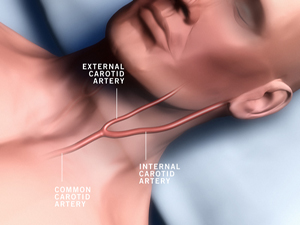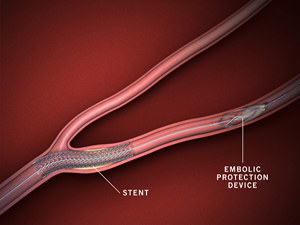Minimally Invasive Procedure Is Option; Found Equally Safe and Effective as Surgery
Stroke is the No. 5 cause of death and the leading cause of adult disability in the United States, according to the American Heart Association. About 795,000 Americans each year suffer a new or recurrent stroke, and nearly 129,000 people a year die of stroke.
 It is estimated that 20% to 30% of strokes are caused by particles of atherosclerotic plaque, which travel upstream into the vessels — the pair of carotid arteries in the neck — that supply the brain.
It is estimated that 20% to 30% of strokes are caused by particles of atherosclerotic plaque, which travel upstream into the vessels — the pair of carotid arteries in the neck — that supply the brain.
Many of these life-threatening strokes can be prevented. For patients with blocked carotid arteries, carotid endarterectomy (removal of plaque) has long been the standard surgical treatment.
Although carotid endarterectomy is well established, the need for therapeutic options is important for certain patients who are not good surgical candidates for it.
For patients considered good candidates for surgery, the option of having a minimally invasive procedure instead of an endarterectomy may offer benefits that are more attractive.
At Stony Brook Medicine, in addition to carotid endarterectomy, our vascular surgeons are skilled at performing carotid stenting that offers an effective treatment option. The "endovascular" (within the vessel) procedure is minimally invasive, and in selected patients it has the potential to be performed as a same-day procedure.
Our multidisciplinary team includes vascular surgeons, cardiologists, neurologists, and neuroradiologists who evaluate each patient and discuss each potential case for stenting. This team approach helps to ensure and distinguish the quality of care that patients receive at the Stony Brook Vascular Center.
- Atherosclerotic plaque buildup in the carotid arteries of the neck can prevent blood from reaching parts of the brain, causing oxygen shortages that can cause transient ischemic attacks or stroke.
- A stent is a thin metal-mesh tube that can be placed inside an artery to keep the artery open and allow blood to flow past plaque blockages.
- Carotid stenting is a treatment that provides an effective means of re-establishing blood flow through blocked carotid arteries.
- Stenting of the carotid artery is a minimally invasive procedure.
As we age, our arteries narrow. They lose their flexibility and the linings thicken. This process is called atherosclerosis or "hardening of the arteries." When the carotid arteries in the neck begin to narrow, blood clots may develop. These arteries may become completely blocked or a piece of clot may break off and travel to the brain. In both cases a stroke — also known as "brain attack" — may result. Transient ischemic attacks ("mini-strokes") may happen first.
Risk of stroke increases as the carotid arteries become more and more narrow. The risk is particularly high after the arteries are blocked more than 70%. The amount of blockage may be determined by a simple painless test called a carotid doppler or carotid ultrasound. People at greatest risk for carotid artery narrowing are those over age 65 (particularly smokers) and those who already have poor circulation in the legs or their heart. Patients who have temporary loss of vision or speech and/or weakening of an arm or leg may have had a mini-stroke and should see their doctor.
CAROTID STENTING
 Carotid stenting is an endovascular procedure in which a tiny, slender metal-mesh tube (stent) is fitted inside a carotid artery to increase the flow of blood blocked by plaques. The stent is inserted in the carotid artery across the blockage and a balloon is threaded up to the blocked artery, and then inflated so that it presses against the plaque, flattening it and re-opening the artery.
Carotid stenting is an endovascular procedure in which a tiny, slender metal-mesh tube (stent) is fitted inside a carotid artery to increase the flow of blood blocked by plaques. The stent is inserted in the carotid artery across the blockage and a balloon is threaded up to the blocked artery, and then inflated so that it presses against the plaque, flattening it and re-opening the artery.
This is all done through a puncture in the groin. The stent acts like a scaffold to prevent the artery from collapsing or being closed by plaque after the procedure is completed.
Stenting is recommended for patients who are unable to undergo carotid endarterectomy, which is the standard treatment for severe buildup of plaque in the carotid artery, and which is the most common vascular surgery performed in the United States today. But for some patients, it may not be appropriate, such as those who cannot tolerate the side effects of anesthesia.
In 2016, the New England Journal of Medicine reported that stenting and surgery are equally safe and effective at reducing stroke risk. The findings of a study of 2,502 patients suggest that doctors and patients can choose either option based on the patient's medical condition and preferences (read more).
The FDA approved the Acculink stent and protection device in 2004 for use in treating carotid artery blockages. The stent system was approved then for use in patients deemed at high risk for carotid endarterectomy, and who had lateralizing cerebrovascular symptoms and a stenosis of at least 50% by angiography or duplex ultrasound.
The FDA also approved this stent for asymptomatic patients whose carotid artery was at least 80% stenotic by angiogram or duplex ultrasound, and who were also deemed high-risk candidates for carotid endarterectomy.
Subsequently, in 2011, the indications for the stent's use were expanded to include patients at standard risk for adverse events from surgery. The Acculink stent is currently the most extensively implanted and studied carotid stent, and is now the only system approved for both high-risk and standard-risk patients. It is the stent used in the study described above.

